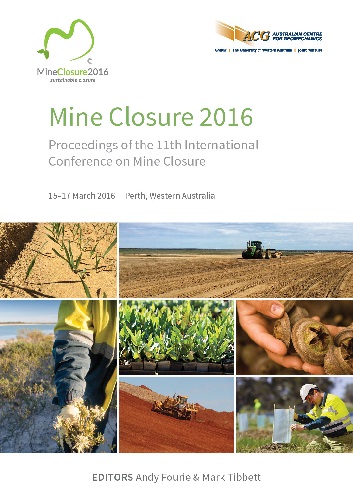Adaptive, integrated water management designs and probabilistic modelling for mine waste facility closure and restoration

|
Authors: Garrick, H; Stewart, F; Hayes, E; Goode, M; Digges La Touche, G |
DOI https://doi.org/10.36487/ACG_rep/1608_34_Garrick
Cite As:
Garrick, H, Stewart, F, Hayes, E, Goode, M & Digges La Touche, G 2016, 'Adaptive, integrated water management designs and probabilistic modelling for mine waste facility closure and restoration', in AB Fourie & M Tibbett (eds), Mine Closure 2016: Proceedings of the 11th International Conference on Mine Closure, Australian Centre for Geomechanics, Perth, pp. 467-480, https://doi.org/10.36487/ACG_rep/1608_34_Garrick
Abstract:
Closed Mine Waste Facilities (MWFs), both tailings and waste rock facilities, represent a potential hazard to the downgradient surface water and groundwater environment. Adaptive, integrated engineering designs at mine sites with short-term life–of-mine resources necessarily mean that closure should be factored into designs and mitigation measures very early in the project lifecycle. Not least, as key decision makers can see the finish line even before the first ore has been shipped. Also, there is emphasis on the importance of having a mechanism for providing a demonstrable analysis, which increases the confidence of the designer/owner, the regulatory authorities, and the public, that the solution is providing environmental protection. The assessment of the long-term risks such facilities pose to the water environment is an important issue for mine closure, particularly when the potential for an impact on the water environment has been identified, necessitating the need to make financial provision for aftercare costs. In addition to the need for financial provision during aftercare, European and international regulatory frameworks require mitigation of potential impacts on the water environment in the long-term, necessitating assessments to account for long-term cover/cap and liner performance as well as changes in climate. This paper presents a case study describing the use of a series of modelling approaches, including probabilistic modelling, to evaluate design performance and risk associated with an Integrated Mine Waste Facility (IMWF) at Dundee Precious Metals Krumovgrad’s (DPMK’s) proposed mine site in Krumovgrad, Bulgaria. The case study illustrates the application of probabilistic modelling involving the use of probabilistic risk assessment to appraise differing closure and remediation strategies for the IMWF at the design stage based on available environmental data. In the case study presented, probabilistic modelling was successfully applied to quantify the nature of the risk to groundwater and surface water in closure, and the degree of amelioration afforded by differing management techniques (placement of a basal liner, installation of a groundwater capture system for a defined period, and capping of the site in closure). The ultimate decision that the site should move forward with a groundwater capture scheme to provide containment for the site during operation and early post closure was supported by impact assessments demonstrating that the tailings and waste rock source would not pose a long-term risk to groundwater and surface water in closure.
Keywords: dynamic simulation, tailings, water balance, cover, cap, liner
References:
EC (European Commission) 2009, Reference Document on Best Available Techniques for Management of Tailings and Waste-Rock in Mining Activities,
EU (European Union) 2000, Directive 2000/60/EC of the European Parliament and of the Council of 23 October 2000 establishing a framework for Community action in the field of water policy.
EU (European Union) 2006a, Directive 2006/11/EC of the European Parliament and of the Council of 15 February 2006 on pollution caused by certain dangerous substances discharged into the aquatic environment of the Community.
EU (European Union) 2006b, Directive 2006/21/EC of the European Parliament and of the Council of 15 March 2006 on the management of waste from extractive industries and amending Directive 2004/35/EC.
EU (European Union) 2006c, Directive 2006/118/EC of the European Parliament and of the Council on the protection of groundwater against pollution and deterioration, 12 December 2006.
Giroud, JP 2001, Evaluation of Use of Bituminous Geomembrane at the Kildare By-Pass.
Giroud, JP & Bonaparte R 1989, ‘Leakage through Liners Constructed with Geomembranes – Part I: Geomembrane Liners’. Geotextiles and Geomembranes, vol. 8, pp. 27–67.
Golder Associates 2014, Post-Closure Seepage Water Quality Predictions, Integrated Mine Waste Facility, Reference KGP100-0500-1000-RPT-1002_B, Lakewood, Colorado.
INAP (The International Network for Acid Prevention) 2009, Global Acid Rock Drainage Guide (GARD Guide),
MEND (Mine Environment Neutral Drainage) 2009, Prediction Manual for Drainage Chemistry from Sulphidic Geologic Materials, MEND Report 1.20.1.
NGCLC (National Groundwater and Contaminated Land Centre) 1999, Guidance on Assigning Values to Uncertain Parameters in Subsurface Fate and Transport Modelling, NGCLC Report NC/99/38/3.
Parkhurst, DL & Appelo, CAJ 2013, Description of input and examples for PHREEQC version 3—A computer program for speciation, batch-reaction, one-dimensional transport, and inverse geochemical calculations: U.S. Geological Survey Techniques and Methods, book 6, chapter A43, p. 497,
Rushton, KR 2003, Groundwater Hydrology: Conceptual and Computational Models, Wiley, Chichester, p. 416.
© Copyright 2025, Australian Centre for Geomechanics (ACG), The University of Western Australia. All rights reserved.
View copyright/legal information
Please direct any queries or error reports to repository-acg@uwa.edu.au
View copyright/legal information
Please direct any queries or error reports to repository-acg@uwa.edu.au